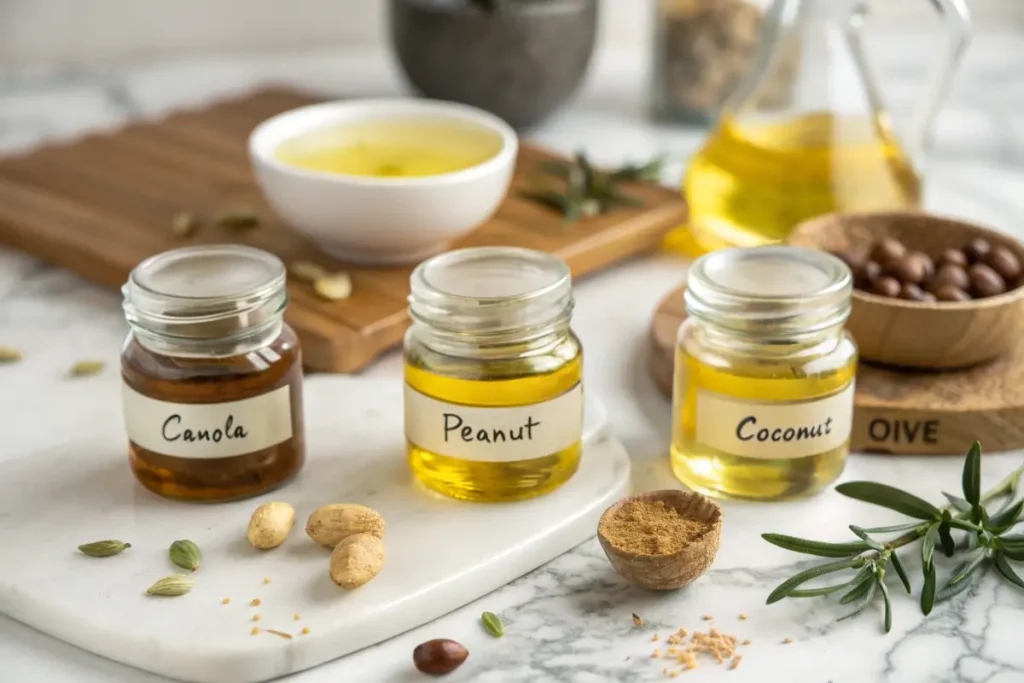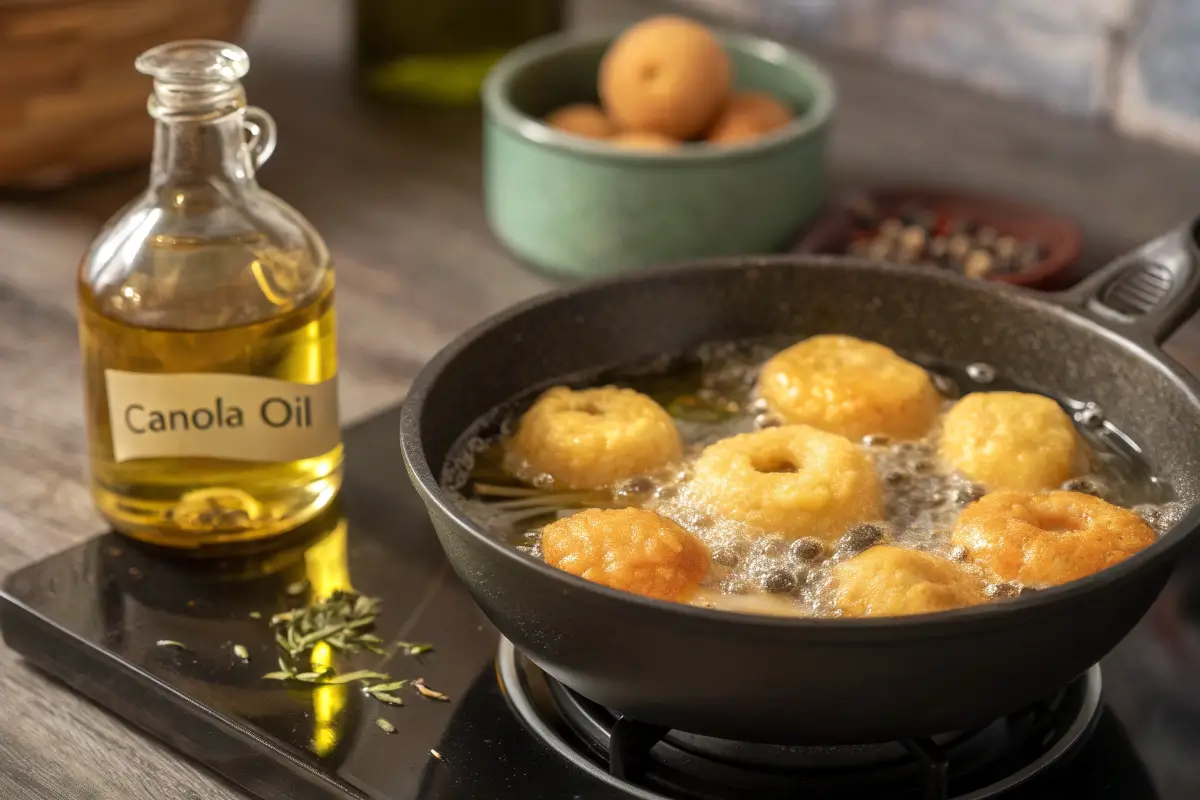Table of Contents
Introduction
What is the best oil for fried dough? That’s a question every home cook and food lover eventually asks when chasing that perfect, golden crisp. Fried dough is a beloved treat across cultures, from fluffy beignets to crispy churros. But the type of oil you choose can make or break the final result.
In this complete guide, we’ll dive into the science and strategy behind selecting the best oils for frying dough. From smoke points and flavor profiles to tips on storage and toppings, you’ll get everything you need to make fried dough that’s crispy, delicious, and maybe even a little healthier.
Understanding the Basics of Fried Dough
What Is Fried Dough?
Fried dough comes in many forms, from crispy beignets in France to doughy zeppoles in Italy. It’s essentially a simple mixture of flour, water, and sometimes eggs, deep-fried until golden brown. This culinary delight is popular in street fairs, carnivals, and even home kitchens, thanks to its comforting taste and satisfying crunch.
Why the Choice of Oil Matters
The oil you use for frying impacts more than just the taste. It determines the texture, crispiness, and even the healthiness of your fried dough. Low-quality or unsuitable oils can leave your treats greasy, while high-quality oils help create a light, airy crust. Moreover, the smoke point—the temperature at which oil begins to break down—is crucial for ensuring safe, flavorful frying.
Health Considerations When Frying Dough
While fried dough is undeniably delicious, it’s no secret that frying adds calories. However, choosing the right oil can make it a bit healthier. Oils high in unsaturated fats, such as canola or olive oil, are often considered better for frying because they contribute less to bad cholesterol. Pairing these oils with proper frying techniques—like maintaining the right temperature and draining excess oil—can help you enjoy fried dough without the guilt.
This section laid the groundwork for understanding fried dough and the importance of selecting the right oil. In the next part, we’ll dive deeper into what makes an oil ideal for frying dough. Stay tuned!
Factors to Consider When Choosing the Best Oil
Smoke Point and Its Importance
When frying dough, one of the first things to consider is the smoke point of the oil. This is the temperature at which the oil begins to break down and produce smoke, potentially altering the taste of your food and releasing harmful compounds. Oils with a high smoke point, such as canola and peanut oil, are ideal for frying since they can withstand the high heat necessary for achieving a crispy exterior.
Flavor Profile: Neutral vs. Flavored Oils
Another key factor is the oil’s flavor profile. Neutral oils like vegetable or canola oil are great for fried dough, as they won’t overshadow the sweet or savory flavors of the dough. However, if you’re after a specific flavor, like the nutty undertone of coconut oil, you can experiment with flavored options. Just keep in mind that stronger oils can dramatically change the final taste.
Health Benefits of Different Oils
Some oils are not only better for frying but also come with added health benefits. For instance, olive oil and avocado oil are high in healthy monounsaturated fats, which can help lower bad cholesterol levels. If you’re looking to balance indulgence with nutrition, these oils could be your best bet. But remember, moderation is key when frying!
The Top Oils for Frying Dough
Canola Oil: The Popular Choice
Canola oil is a favorite for frying due to its high smoke point (around 400°F) and neutral flavor. It’s also relatively inexpensive, making it perfect for large batches of fried dough. Since it’s rich in omega-3 fatty acids, it offers a healthier edge compared to traditional frying oils.
Peanut Oil: For a Crispy Texture
For those seeking an extra-crispy texture, peanut oil is a fantastic choice. With its high smoke point of 450°F, it handles the heat exceptionally well, producing perfectly golden fried dough. Plus, its subtle nutty flavor can enhance certain recipes, adding depth to your sweet treats.
Vegetable Oil: Budget-Friendly and Effective
Vegetable oil is a versatile and cost-effective option for frying dough. It has a moderately high smoke point and a mild flavor, making it a reliable choice for various types of fried dough, from doughnuts to churros.

Olive Oil: A Healthier Alternative?
Although olive oil is typically associated with sautéing and dressing salads, it can also be used for frying certain types of dough. Extra virgin olive oil has a lower smoke point, so it’s best suited for shallow frying rather than deep-frying. However, its robust flavor and health benefits make it an appealing option for those looking to fry dough more health-consciously.
Coconut Oil: For a Unique Flavor
Coconut oil adds a distinct, slightly sweet flavor to fried dough, making it a popular choice for exotic recipes. It has a smoke point of around 350°F, so it’s better for low-to-medium heat frying. Additionally, coconut oil is rich in lauric acid, which is believed to have antimicrobial properties.
To explore related recipes, check out this guide on the ingredients for fried dough to ensure your frying experience is seamless!
Tips for Perfectly Fried Dough
Proper Temperature Control
Getting the oil temperature right is crucial for perfectly fried dough. Too hot, and the dough might burn before it’s fully cooked inside. Too cold, and you’ll end up with greasy, soggy treats. The sweet spot for most oils is around 350°F to 375°F. Use a kitchen thermometer to monitor the heat, ensuring a consistent temperature throughout the frying process. If you don’t have one, test the oil by dropping a small piece of dough—if it sizzles and floats, you’re good to go.
How Much Oil to Use
The amount of oil can make or break your frying success. For deep-frying, the dough should be fully submerged to ensure even cooking and a crispy texture. Use a heavy-bottomed pot to distribute heat evenly and prevent oil splatter. If you prefer shallow frying, ensure the oil depth is at least halfway up the dough to cook it evenly on both sides.
Draining Excess Oil for Crispiness
No one likes greasy fried dough. Once you’ve fried your dough to golden perfection, place it on a cooling rack lined with paper towels to drain the excess oil. This step keeps the dough crisp while removing unnecessary grease. Another tip? Sprinkle your toppings—sugar, cinnamon, or glaze—while the dough is still warm for the best flavor.
FAQs About Oils for Fried Dough
Is It Safe to Reuse Frying Oil?
Yes, but only under certain conditions. Reusing oil can save money, but it’s essential to strain out food particles and store it properly. Oils with high smoke points, like peanut or canola oil, are better for reuse since they break down more slowly.
What Is the Best Oil for Sweet Fried Dough?
For sweet fried dough, neutral oils like vegetable or canola oil are ideal since they don’t overpower the flavor. If you’re after a hint of sweetness, coconut oil is a fantastic choice that adds a subtle tropical twist.
How Can I Tell If My Oil Is Too Hot?
An easy way to check if your oil is too hot is by observing its appearance. If it starts smoking or darkening, it’s time to lower the heat. A thermometer is your best friend here, keeping the temperature in the perfect range for frying dough.
Can I Mix Different Types of Oil?
Absolutely! Mixing oils is a great way to balance flavor and performance. For example, blending olive oil with a neutral oil like canola allows you to enjoy its health benefits without compromising the dough’s texture.
For more tips on frying and baking techniques, check out this pumpkin banana loaf recipe, a delicious complement to fried dough treats!
Common Mistakes When Frying Dough and How to Avoid Them
Overcrowding the Frying Pan
One of the most common mistakes people make when frying dough is overcrowding the pan. This leads to a drop in oil temperature, resulting in unevenly cooked or soggy dough. To avoid this, fry only a few pieces at a time, leaving enough space for the dough to cook evenly. Maintaining the right temperature is key to answering the question, What is the best oil for fried dough?, as even the perfect oil won’t save overcrowded frying.
Not Draining the Dough Properly
Failing to drain the fried dough can lead to greasy treats that lose their crispiness quickly. Always place freshly fried dough on a cooling rack lined with paper towels to absorb excess oil. For a pro tip, use a slotted spoon or skimmer to lift the dough out of the oil to minimize grease.
Using the Wrong Temperature
Temperature control is everything when it comes to frying. If the oil is too cold, the dough absorbs too much oil, while overly hot oil burns the exterior before the inside cooks. Investing in a kitchen thermometer helps you nail the perfect frying temp.
Pairing Fried Dough with Delicious Toppings

Classic Toppings
Once you’ve mastered the art of frying dough, the fun part begins—toppings! For a traditional approach, sprinkle powdered sugar or cinnamon sugar over warm dough. These classics enhance the natural sweetness without overpowering the fried treat.
Creative Twists
If you’re feeling adventurous, try drizzling chocolate or caramel sauce over your fried dough. Fresh fruit like strawberries or bananas adds a refreshing contrast to the richness. Want something savory? Sprinkle a bit of sea salt or grated cheese for a unique flavor experience.
For more ideas on pairing desserts with fried dough, check out this pumpkin banana loaf recipe.
Storing and Reheating Fried Dough
How to Store Fried Dough Properly
Storing fried dough the right way ensures it stays fresh and crispy. First, allow the dough to cool completely to prevent condensation, which can make it soggy. Once cooled, place it in an airtight container or wrap it tightly with plastic wrap. Store at room temperature for up to two days. If you plan to keep it longer, freeze the dough in a sealed bag, making sure to separate each piece with wax paper to prevent sticking.
Best Way to Reheat Fried Dough
To restore its crispy texture, reheat fried dough in an oven or air fryer. Set the oven to 350°F and place the dough on a baking sheet for about 5-7 minutes. Avoid microwaving, as this can make the dough chewy. Reheating properly allows you to enjoy that freshly fried taste, making the quest for What is the best oil for fried dough? all the more rewarding.
Choosing the Right Oil for Specific Fried Dough Recipes
Light and Fluffy Doughs
For light, airy doughs like beignets or zeppoles, choose oils with neutral flavors, such as canola or vegetable oil. These options won’t interfere with the subtle sweetness of the dough, allowing the flavors to shine.
Rich and Decadent Doughs
Heavier doughs, like those used for fried doughnuts or crullers, pair well with oils that add a hint of richness. Coconut oil is an excellent choice, providing a slight sweetness that complements the decadence of these treats. For those wondering What is the best oil for fried dough? in sweet recipes, coconut oil is a top contender.
This wraps up our guide to mastering fried dough. From selecting the right oil to reheating for the perfect crunch, every step brings you closer to delicious, golden perfection!

